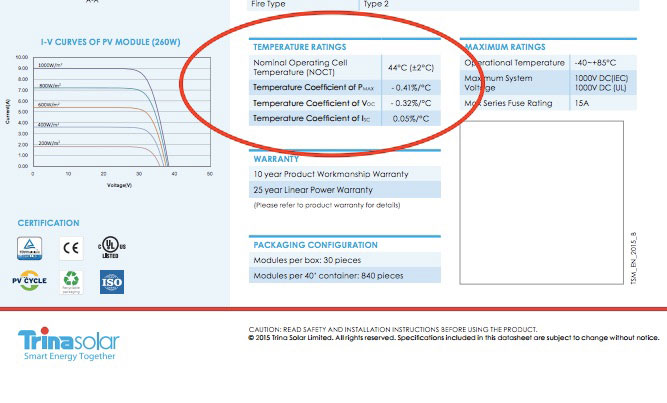What is the temperature coefficient of a solar module?
Each solar cell technology comes with a unique temperature coefficient. This temperature coefficient is important as the temperature of the solar cell has a direct influence on the power output of a solar module. As the temperature in which a solar module operates increases, the power output of the solar module will decrease. Crystalline solar cells are the main cell technology and usually come with a temperature coefficient of around -0.5% / Degrees Celsius. The rated power on the module’s label is measured at 25 degrees Celsius, and with any temperature increase above °C 25, you have to take into account a power loss of 1% for every °C2 increase. Most installed solar modules in sunny countries easily reach temperatures higher than °C25. In fact, a temperature of °C50 can be easily reached. Here’s a screenshot from Trina Solar ALL-Max solar module:
 Temperature coefficient solar panel - Trina Solar[/caption] Let’s take Trina Solar’s solar module as an example, and calculate the power loss when these solar modules are installed in a hot country: We pick their currently highest power poly 60Cell: the 260W. Let’s have a look at an example if the solar cells inside a solar module reach °C65: With the solar module reaching °C65, the power loss of this module is: °C65 – °C25 = °C40 °C40 x -0.41% = -16.4% Solar module power loss: -16.4% x 260W = 42.64W The max. power this module will operate is 217W. Good to know when you're calculating the ROI of your PV plant!
Temperature coefficient solar panel - Trina Solar[/caption] Let’s take Trina Solar’s solar module as an example, and calculate the power loss when these solar modules are installed in a hot country: We pick their currently highest power poly 60Cell: the 260W. Let’s have a look at an example if the solar cells inside a solar module reach °C65: With the solar module reaching °C65, the power loss of this module is: °C65 – °C25 = °C40 °C40 x -0.41% = -16.4% Solar module power loss: -16.4% x 260W = 42.64W The max. power this module will operate is 217W. Good to know when you're calculating the ROI of your PV plant!
Kevin Robinson
on 31 Jul 2017kimi
on 06 Jul 2018ravikumar
on 24 Feb 2023Taranjeet singh
on 01 Feb 2020